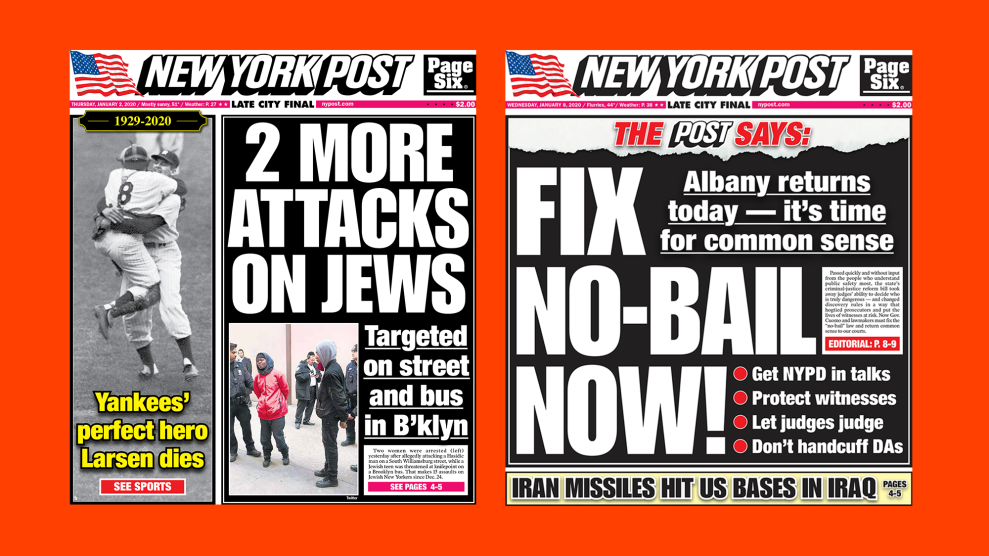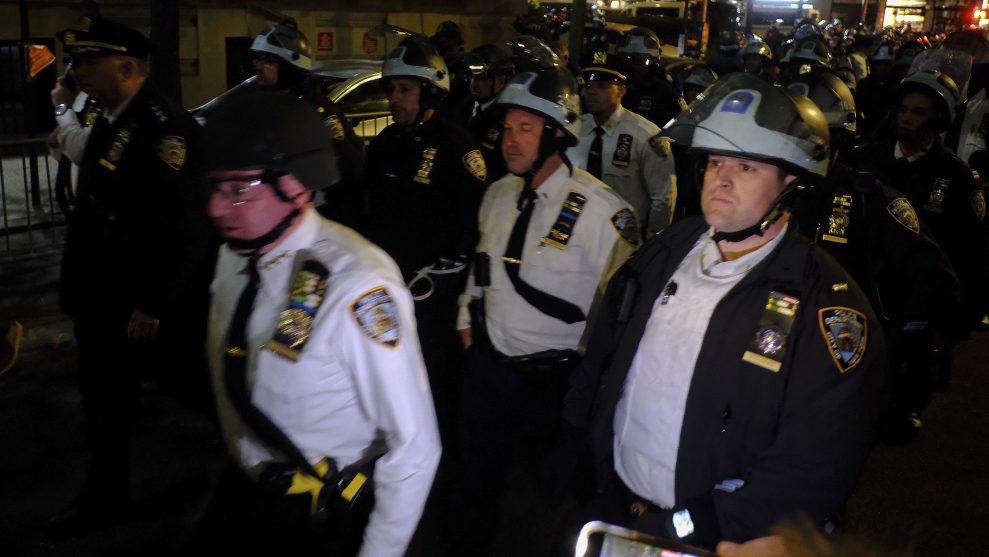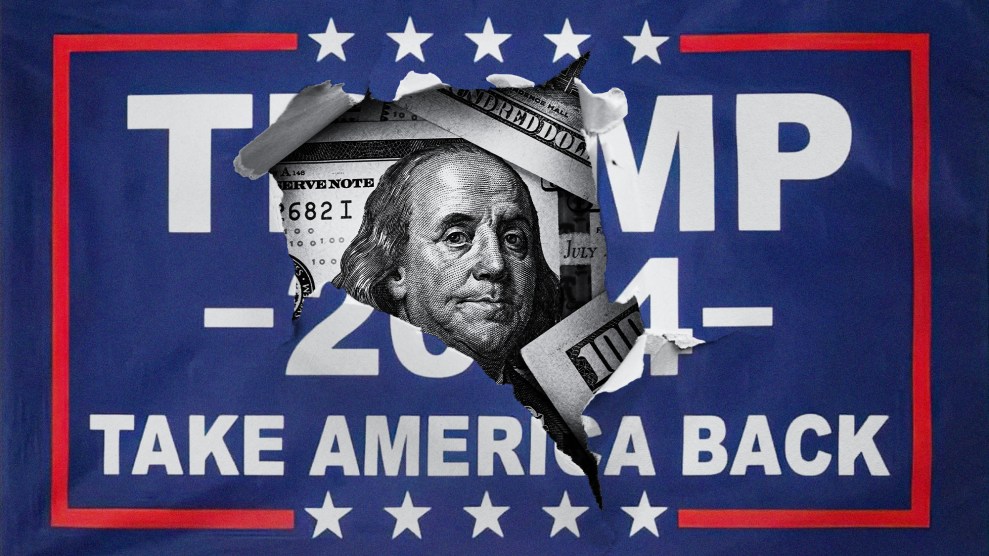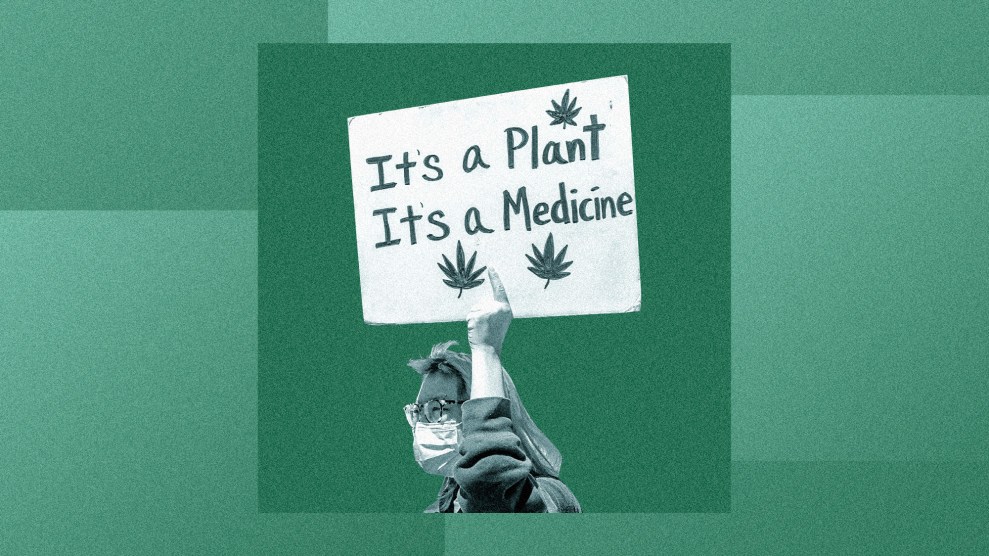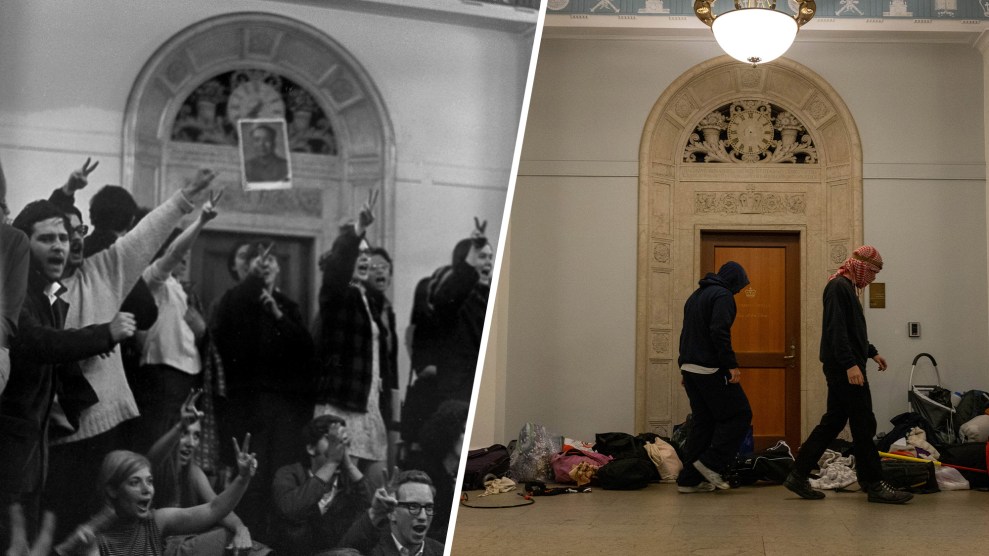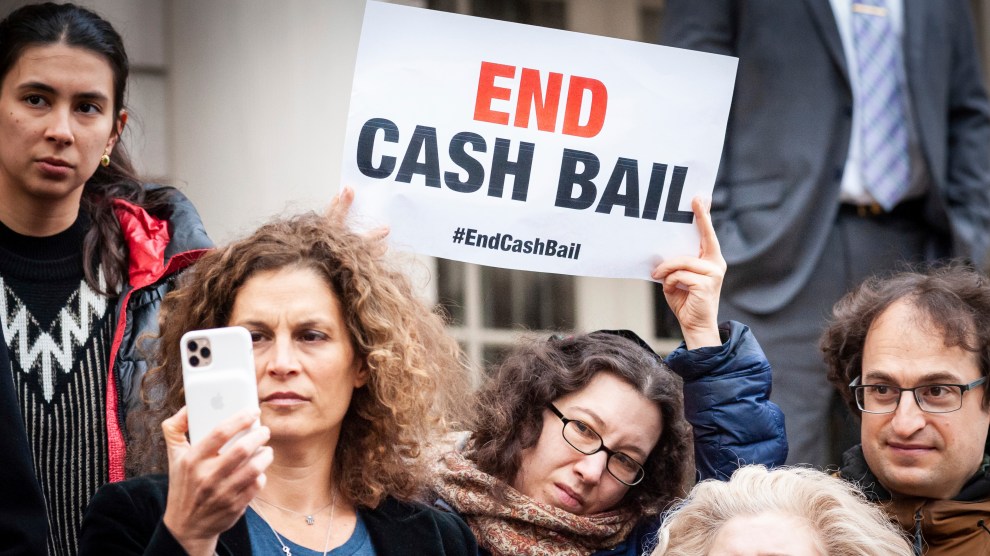
People show support for bail reform at a rally in New York City in January. (Photo by Gabriele Holtermann-Gorden/Sipa USA)(Sipa via AP Images)Gabriele Holtermann-Gorden/Sipa USA via AP Images
In 2017, a retired shipyard worker named Kenneth Humphrey was arrested in San Francisco for allegedly breaking into his neighbor’s house, threatening him, and stealing $5 and a bottle of cologne. Humphrey, who was 63 and had a record of previous arrests, was quickly booked into a local jail. As he waited for trial, a judge gave him the option to go home—but only if he forked over $600,000 in bail. Humphrey couldn’t afford it and ended up waiting behind bars for nearly a year, all for stealing a few bucks.
Progressives have long argued that the cash bail system, which requires people to pay money as collateral if they want to get out of jail before their court hearings, disproportionately incarcerates low-income people of color like Humphrey. Because of this, criminal justice reform advocates on the left almost universally despise this wealth-based incarceration system.
So when a measure that would make California the first state to completely abolish cash bail landed on the ballot this year, you might have expected it to garner widespread support, given the state’s liberal leanings. Instead, progressives are fiercely divided over Proposition 25.
Even if you don’t live in California, this is a vote to watch. Former Vice President Joe Biden and California Sen. Kamala Harris both support abolishing cash bail, and other states will likely weigh in on this issue in future years—some like New York already have. Plus, California accounts for about a quarter of America’s multibillion-dollar bail industry, and a significant chunk of its profits. “So if you’re trying to cut the head off the dragon, this is where the head is,” says John Bauters of Californians for Safety and Justice, a criminal justice reform group that helped pass previous ballot measures to reduce the prison population, and which supports Prop. 25. “If we eliminate this industry here, it would have a big domino effect,” he says.
But even people who agree there are major problems with the cash bail system don’t agree on whether to support this proposition. Groups including Human Rights Watch and the ACLU of Southern California worry the replacement for cash bail that Prop. 25 proposes will do more harm to people of color than the current system—and possibly land more of them in jail. The measure is “essentially a wish list or power grab for judges and probation departments,” John Raphling of Human Rights Watch says. “You’re creating a monster here,” adds Lex Steppling of Dignity and Power Now, part of a coalition of reform groups in Los Angeles that think the law is a step backward. “It’s a mass jailing bill.”
This complicated but hugely important debate could affect hundreds of thousands of people who cycle through jails each year. To make sense of it all, I called California progressives on both sides of the argument to hear their thoughts on the ballot measure and whether it signifies the beginning of the end of cash bail.
How does the cash bail system work in California, and why do most progressives agree we need to change it?
When someone is arrested and charged with a crime, a court decides whether to make the person wait in jail before trial. If a judge worries the defendant will flee or break the law again if he’s released, she will require him to post bail first—forcing him to put up sometimes tens or hundreds of thousands of dollars as collateral.
Judges have a lot of discretion to choose how much a person pays. The Judicial Council of California, a rule-making body composed largely of judges, sets the bail schedule in each county, recommending limits for the bail amounts that can be applied for various offenses. Individual judges then decide what precise amount to demand for a particular case.
Researchers have shown that these judges regularly choose higher amounts for people of color. For instance, Humphrey, who is Black, was initially asked to pay $600,000, which was later reduced to $350,000. Meanwhile, another judge in the state asked Brock Turner, a white man, to pay a fraction of that amount, $150,000, for raping his unconscious classmate at Stanford. Turner could afford it. Humphrey could not.
When defendants don’t have enough cash on hand, some turn to bail bond companies, which promise to pay the court if the person is released but doesn’t show up for trial. These companies charge people a fee—normally around 10 percent of the bail, or $60,000 in Humphrey’s case—that is nonrefundable, even if the person wins at trial. When defendants can’t afford to pay the bail bond company, they get stuck in jail like Humphrey.
Progressives criticize the bail system because it penalizes people who don’t have a lot of money, often people of color. It can also encourage people to plead guilty to crimes, even if they’re innocent—simply so they can return to their jobs and kids, rather than waiting for trial in jail. Then they’re saddled with a felony conviction that can make it harder down the line for them to find employment or housing.
What would Prop. 25 do?
In 2018, California lawmakers passed a historic bill to abolish their state’s cash bail system. This year’s ballot measure, Proposition 25, is a referendum on that law, which means if voters pass it, the law will go into effect. It’s being pushed by many leaders of the state’s Democratic Party, and by a host of local criminal justice reform organizations.
Prop. 25 still gives judges discretion to detain people before trial. Many defendants accused of some misdemeanors, especially nonviolent misdemeanors like trespassing, would be allowed to go home automatically, as long as they’re not already on parole for another offense or have a history of skipping court. They might have to follow certain conditions like wearing an ankle bracelet.
But people accused of felonies and certain violent misdemeanors could still be jailed while awaiting trial. Prop. 25 replaces cash bail with something else: Instead of looking at bail schedules, judges would decide whether to release people with help from risk assessment tools—which harness algorithms to guess a person’s odds of committing another offense or skipping court. These tools, which many California counties and some states already use in various capacities, often evaluate things like employment status and criminal history to categorize people as low risk, medium risk, or high risk. Based partly on these odds, a judge could decide whether to detain them pretrial, or to release them under certain conditions, like requiring them to check in regularly with probation officers.
The proposition has gained support from the California Democratic Party’s executive board, Gov. Gavin Newsom, US Reps. Karen Bass and Ted Lieu, the California Public Defenders Association, and the SEIU California State Council, a union organization. They see it as a way to finally get rid of the exploitative bail bond industry and allow more people to go home before their trials.
Why do some progressives hate this idea?
While just about everyone on the left can agree that the current bail system is racist, some progressives worry the risk assessment system will be worse, and that judges will use it to lock up even more people than before.
Risk assessment tools like these are often developed by private companies, and they make their calculations based on a bunch of data, usually including a person’s prior arrest record. That’s problematic from a racial justice standpoint, since people of color are more likely to have criminal histories, partly because they live in neighborhoods that are more likely to be overpoliced. As a result of their skin color, they’re also more likely to be arrested, charged, prosecuted, and given harsher sentences. Which means the people who were jailed most often by the bail system are also more likely to be jailed by the risk assessment system.
And some progressives worry that once a person is jailed, there will be no way to get them out. Bail at least provided an escape valve. Now, they fear, “there will be no more bailouts. There will be nothing we can do,” says Steppling. He worries judges will overwhelmingly use their discretion to jail anyone who scores medium or high risk.
Plus, he says Prop. 25 makes too many exceptions that allow people with certain misdemeanors to be detained. He also worries the ballot measure would give more power to probation departments, which would be tasked with running the risk assessment calculations, supervising people who are released, and offering other pretrial services. Some progressives would prefer nonprofit mental health or human services agencies to handle these tasks.
Among the groups that oppose Prop. 25 are the ACLU of Southern California, Human Rights Watch, the California State Conference of the NAACP, and the LA County Public Defender Union.
Rapper Snoop Dogg has also urged his fans to reject the measure, writing on Instagram that it would give too much power to Republican judges and prosecutors. The state’s Republican Party opposes Prop. 25, too, along with the bail industry and most law enforcement unions, which often stand against criminal justice reforms that seek to reduce incarceration.
Are there any safeguards to make the risk assessment tools less racist and help people get out of jail if they’re wrongfully detained?
Yes. California lawmakers passed a follow-up law in 2019 that requires the risk assessment tools to be “validated” locally every few years, which means counties have to examine whether the algorithms will classify people in ways that accurately reflect their risk to public safety. The same algorithm probably wouldn’t work in every city, since each jurisdiction has different laws, agency policies, and local supervision conditions.
And for transparency, counties would have to publicly identify all the factors they’re using to make the calculations, and also how they’re weighing these factors. Reports would be published once annually about the racial disparities that result from the risk assessment tools, indicating whether people of color are being disproportionately jailed. Proponents say this could expose racist judges and lead to more accountability.
To detain someone pretrial, prosecutors would also have to file a motion and argue their position at a hearing in front of a judge. Anyone forced to stay in jail could appeal. But progressive critics of Prop. 25 worry most defendants would lose.
How do Prop. 25 supporters defend the risk assessment tools?
Even some of the most ardent supporters acknowledge that the proposition isn’t perfect, and that risk assessment tools might disproportionately harm people of color. But on balance, they say, it will harm fewer of them than the current bail system. “We do not pretend that [Prop. 25] is a panacea, that this is going to eliminate racism,” says Bauters of Californians for Safety and Justice, “but we really view it as a significant step forward in the path to doing that.”
Many California counties already use risk assessment tools as they set bail or decide who gets access to pretrial services, he adds, and they often do so with less transparency than the proposition requires.
He adds that if voters don’t pass the ballot measure now, state lawmakers might assume people prefer the status quo and refrain from passing other reforms later. Getting rid of the bail bond industry, he adds, will make it much easier to push for more progressive improvements going forward, because the industry will no longer have the profits to spend millions of dollars lobbying against reforms.
One side says fewer people will be detained under Prop. 25; the other side says more people will be detained. Who’s right?
It’s hard to know for sure, but there are some experiments we can look to as examples.
New Jersey largely eliminated cash bail in 2017 and used risk assessment tools to help decide who was jailed. It seemed to work well: Pretrial detention dropped in half, without a significant increase in people failing to appear in court or committing new crimes. But other criminal justice reforms enacted around the same time may have contributed to this outcome. Plus, the Pretrial Justice Institute, a nonprofit that originally urged New Jersey to adopt the risk assessment tools, later backtracked and recommended the state ditch them for good. The institute’s experts argued that in some jurisdictions, these tools actually increased racial disparities. (Across New Jersey, the demographics of people in jail didn’t change much after the reforms—about half of these people were Black and a third were white.)
In California, researchers have tried to predict how Prop. 25 might affect jail populations in at least a few different studies. The Public Policy Institute of California had some rosy estimates: About 142,000 people who are currently detained or released after about two days for misdemeanor charges would instead be released within 12 hours. That might not sound like much of a difference, but research shows that people who are freed within a day are much less likely to be rearrested or miss their court dates.
But the PPI study also estimated that about 3,000 people accused of felonies who are currently released in a few hours would instead by held for up to 36 hours for risk assessment. And it predicted that “existing inequities in arrest, booking, and criminal history would likely lead African Americans to be held more often for risk assessment than other racial groups.”
Another study, by the California Policy Lab at the University of California-Berkeley, also estimated that more people would be released from jail before their arraignments under Prop. 25. The proportion of defendants released would rise from 44 to 59 percent in San Francisco, the researchers predicted. But this study was partially funded by Arnold Ventures, an organization that developed a well-known risk assessment tool and stands to benefit if the ballot measure passes. And the researchers acknowledge their predictions may be overestimates, because they’re based on assumptions that judges would usually use their discretion in favor of releasing people. Tweak those assumptions, says Raphling of Human Rights Watch, who examined the data, and even more people could be detained than currently.
Are there any alternatives to risk assessment?
Yes. Last January, New York significantly scaled back its cash bail system without relying on risk assessment tools. Under the new system, judges decide who goes free based on what type of crime they committed. Most people accused of nonviolent misdemeanors and nonviolent felonies are automatically released. Risk assessment tools may be used to help assess whether they can be freed without any conditions, like a requirement to wear an ankle bracelet. But the tools don’t determine who’s jailed.
The JusticeLA Coalition, which includes Human Rights Watch and grassroots groups like Dignity and Power Now that oppose Prop. 25, want lawmakers to create a system where most people are automatically released before their trial. Under their proposal, a small number of people could still be detained if they pose a risk of harming someone else, but only after a hearing that’s more rigorous than the one envisioned by Prop. 25.
These grassroots groups don’t buy the argument that lawmakers will refrain from passing more radical changes later if voters reject the ballot measure now. “This is one of the biggest lines of bullshit,” says Steppling of Dignity and Power Now, who believes sweeping reforms that don’t involve risk assessment tools are possible. Proponents of Prop. 25 espouse the idea “that nothing else is feasible at the state, that this is the best we can do,” he says.
But “if we build a strong, powerful movement, they will have to go along with what we want,” adds Raphling of Human Rights Watch. “We’re not taking cues from what the political establishment says we can do.”
This article has been updated to clarify that Arnold Ventures does not derive revenue from distribution of its risk assessment tool.

